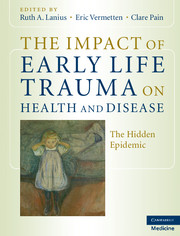16 results
Machine learning multivariate pattern analysis predicts classification of posttraumatic stress disorder and its dissociative subtype: a multimodal neuroimaging approach
-
- Journal:
- Psychological Medicine / Volume 49 / Issue 12 / September 2019
- Published online by Cambridge University Press:
- 11 October 2018, pp. 2049-2059
-
- Article
- Export citation
Acknowledgements
-
-
- Book:
- The Impact of Early Life Trauma on Health and Disease
- Published online:
- 03 May 2011
- Print publication:
- 05 August 2010, pp xvii-xviii
-
- Chapter
- Export citation
Epilogue
-
- Book:
- The Impact of Early Life Trauma on Health and Disease
- Published online:
- 03 May 2011
- Print publication:
- 05 August 2010, pp 300-302
-
- Chapter
- Export citation
The Impact of Early Life Trauma on Health and Disease - Title page
-
-
- Book:
- The Impact of Early Life Trauma on Health and Disease
- Published online:
- 03 May 2011
- Print publication:
- 05 August 2010, pp iii-iii
-
- Chapter
- Export citation
Section 3 - Clinical perspectives: assessment and treatment of trauma spectrum disorders
-
- Book:
- The Impact of Early Life Trauma on Health and Disease
- Published online:
- 03 May 2011
- Print publication:
- 05 August 2010, pp 205-299
-
- Chapter
- Export citation
Section 1 - Early life trauma: impact on health and disease
-
- Book:
- The Impact of Early Life Trauma on Health and Disease
- Published online:
- 03 May 2011
- Print publication:
- 05 August 2010, pp 1-92
-
- Chapter
- Export citation
Contents
-
- Book:
- The Impact of Early Life Trauma on Health and Disease
- Published online:
- 03 May 2011
- Print publication:
- 05 August 2010, pp v-vi
-
- Chapter
- Export citation
Contributors
-
-
- Book:
- The Impact of Early Life Trauma on Health and Disease
- Published online:
- 03 May 2011
- Print publication:
- 05 August 2010, pp vii-xii
-
- Chapter
- Export citation
Chapter 16 - Long-lasting effects of childhood abuse on neurobiology
- from Section 2 - Biological approaches to early life trauma
-
-
- Book:
- The Impact of Early Life Trauma on Health and Disease
- Published online:
- 03 May 2011
- Print publication:
- 05 August 2010, pp 166-177
-
- Chapter
- Export citation
The Impact of Early Life Trauma on Health and Disease - Half title page
-
- Book:
- The Impact of Early Life Trauma on Health and Disease
- Published online:
- 03 May 2011
- Print publication:
- 05 August 2010, pp i-ii
-
- Chapter
- Export citation
Copyright page
-
- Book:
- The Impact of Early Life Trauma on Health and Disease
- Published online:
- 03 May 2011
- Print publication:
- 05 August 2010, pp iv-iv
-
- Chapter
- Export citation
Index
-
- Book:
- The Impact of Early Life Trauma on Health and Disease
- Published online:
- 03 May 2011
- Print publication:
- 05 August 2010, pp 303-315
-
- Chapter
- Export citation
Chapter 27 - Psychodynamic psychotherapy: adaptations for the treatment of patients with chronic complex post-traumatic stress disorder
- from Section 3 - Clinical perspectives: assessment and treatment of trauma spectrum disorders
-
-
- Book:
- The Impact of Early Life Trauma on Health and Disease
- Published online:
- 03 May 2011
- Print publication:
- 05 August 2010, pp 286-294
-
- Chapter
- Export citation
Chapter 17 - Biological framework for traumatic dissociation related to early life trauma
- from Section 2 - Biological approaches to early life trauma
-
-
- Book:
- The Impact of Early Life Trauma on Health and Disease
- Published online:
- 03 May 2011
- Print publication:
- 05 August 2010, pp 178-188
-
- Chapter
- Export citation

The Impact of Early Life Trauma on Health and Disease
- The Hidden Epidemic
-
- Published online:
- 03 May 2011
- Print publication:
- 05 August 2010
Section 2 - Biological approaches to early life trauma
-
- Book:
- The Impact of Early Life Trauma on Health and Disease
- Published online:
- 03 May 2011
- Print publication:
- 05 August 2010, pp 93-204
-
- Chapter
- Export citation



